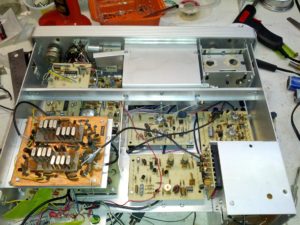Tag Archives: radio repair
For those that do know me in real life, I’m not an electrical engineer, I’m a traffic engineer (more specifically, I do traffic forecasting, which also makes me somewhat of a programmer and a transportation planner). I can build electrical things when they’re easy or when there’s a schematic.
For those that have been following this blog, I just put my only real* HF rig in my truck.
For those of you that have been following me on Twitter and have a damn good memory, you may remember my first rig was a Ten Tec Omni.
So enter my issue. I have a broken (but otherwise great) rig at home, I’m too cheap to send it to Ten Tec**, and I want to learn more about repairing my equipment. This is a lot harder than Arduinos and Raspberry Pis and Beagle Bones!
The Transceiver
The transceiver is a Ten Tec Omni C Model 546. It has all the options – three crystal filters (2.4 KHz, 1.8 KHz, and 500 Hz) and three audio filters (10 KHz, 500 Hz, and 150 Hz of audio) PLUS the WARC band (12 meter and 17 meter) crystals installed.
The guts of the rig are modules – each plugs into the chassis.
The Problem
While running around 25 watts out on the NAQP RTTY contest a few years ago, the rig and power supply died mid-transmission. I tried throwing the switch off then on, and the I saw the lights (the meter and the frequency display) light up and immediately die.
I tested the power supply, and it has 13.8 volts out.
I put an ohmmeter on the rig’s power connectors and saw very low ohms (something like 200 ohms). Seems to me that a part failed and opened a path to ground. With that thought in mind, I did check the 1 uF capacitor and the diode that connect between the +V in and ground (those seemed like the easy tests. I basically disconnected both from ground and tested the resistance betweren +V and GND and there was no change in resistance. However, the rig is modular, and there are dozens of places where there is a capacitor between a +V and GND connection.
My Thoughts
One thing about this rig is that everything is modular. I can remove parts very easily and test the resistance to ground (which I’m guessing should be very high). So if I find something that has a low resistance to ground (in the ohms instead of kilo-ohms), I should probably start looking there.
One thing I did do is remove the meter light bulb and the resistance went up to 450 ohms. It seems to me that the resistance should be somewhere in the 10 kilo-ohm range, but again, I’m not an electrical engineer.
Reader Participation
Let me know in the comments, via twitter, Google+, or email – am I on the right track? Anyone have one of these and know of a common failure? I’ll gather a work-week’s worth of comments and do tests on the weekend (or through the week, if I have the time).

